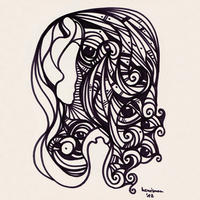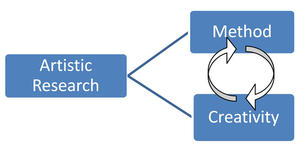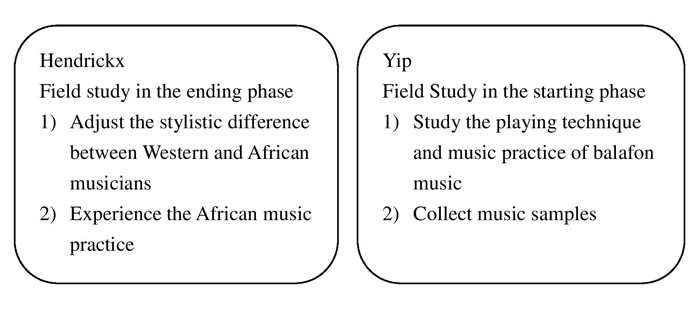The Creativity in Artistic Research Method

Conference paper submitted to 3rd European Platform for Artistic Research in Music (EPARM)
Artistic research is considered as a dualistic concept, a combination of art and research. On one side, artistic research deals with art, concerning sensitivity, intuition and abstract concepts; on the other side, it contains a research component, which requires rational thinking, system and method. While art celebrates creativity, research emphasizes method. The two items are usually considered as contradictory.
I would like to reflect on the two-way relationship of method and creativity. The idea is shown in a simple diagram.
The first arrow is going from creativity to method. It represents the notion of creativity bringing method into existence. A short definition of creativity: it is the genesis of thinking, like ideas, rules and interpretation, through imagination and intuition. It brings a theory, a concept or an artifact into existence. Thus, creativity is imbued in the process of forming a research method and vice versa, method is an inevitable product of creativity.
Another arrow is drawn from method to creativity. Method pertains to different roles in different kinds of research. Taking scientific research as an example, method is equivalent to mathematical equation or laboratory formula, which is a well-defined pathway of inquiry; but in artistic research, method is not designed to solve a math problem, it is like a open-ended pathway, guiding an artist in how and what to create to demonstrate his/her viewpoints and to answer the research question. It is undeniable that creativity is provoked by method when the research proceeds. Research method is to inspire and brings out artistic outcomes—the artifact, interpretation and practice.
But one criteria of creativity should not be neglected: the originality of an individual that is imbued in the creative process, one interesting causal factor that never two creative minds are exactly the same. A term ‘artistic idiosyncrasy’ is used specifically in this article to describe the originality of the artist, the eccentricity and peculiarity that is embedded in his/her artistic creation. In other words, if we assume creativity creates research method, then artistic idiosyncrasy imbued in creativity is also embedded in the formation of research method.
I am going to discuss two examples of artistic research to exemplify the above viewpoints—my research project Investigating New Marimba Performance Techniques from its African Heritage and the Confrontation project by Wim Henderickx. The projects share the same initiative—to combine the Western and non-Western musical styles in one composition.
As a performer in classical percussion and marimba, the aim of my project is to explore new performance techniques and musical interpretation to enrich the present repertoire of the instruments. The sources of inspiration come from the balafon music of the West Africa, the music traditions in Mali and Burkina Faso.
Both performances require the same physical mechanism of the arm, but contain diverse musical and technical styles. I was fascinated by the polyrhythmic structure of the African genre and the energetic atmosphere that traditional balafon musicians are able to project in a performance; as well as the high level dexterity in the playing technique that always impresses every Western percussionist. As such, I would like to reproduce and translate these African nuances in my performance.
Barica by Youssouf and Kassoum Keita:
Classical marimba performance by Adilia YIP:
Here is a plot of the research method. There are three steps: field study, analysis of balafon music and to produce new works.
First, I started the project with a field study: to learn the balafon music with the traditional musicians in Africa, so as to observe the performance technique and music interpretation in the tradition. And definitely, it is important to interact with the local culture and to collect music samples in the field. From the field study, I observed that traditional musicians pursue a holistic approach in teaching and learning. And due to the oral tradition, balafon music is communicated only via listening and imitation, without any traces of notation. I have also learnt the coordination technique ‘two-ways coordination’ with the traditional musicians, which is a kind of parallel motor control between the left and right hand, that the left hand can play a repetitive phrase while right hand is improvising independently, or vice versa. The differences in performance practice and playing technique have become interesting material for making new repertoire for the marimba.
Learning balafon technique ‘two-ways coordination’ with teacher Youssouf Keita during the workshop:
Youssouf teaching his son:
Let’s move to the second project.
In 2003, Het Zuiderpershuis, a cultural center for world music in Antwerp had commissioned composer Wim Henderickx to create a music project that combined the Western and African genre. The aim was to promote multiculturalism in the society via a music project, a fusion between the Western and non-Western tradition. The composer gave the work the title ‘Confrontation’, which refers both to the encounter of two diverse music traditions, and to the stage where an equal number of African and Western musicians play on their own instruments. The setting was designed to let the two musical cultures to enter into a ‘confrontation’, but also to ‘melt’ together. Here is another flow chart to illustrate the proceedings:
Henderickx had merged the Madinga drumming and dance music of Burkina Faso with this with his own Western composing concepts. The performance was a mixture of improvisation and notation. The instrumentation is a combination of African and Western percussion, such as: djembe, dundun and balaphon of the African tradition, and opposite to it: marimba, chimes and all kinds of drums and percussion instruments of the Western world.Therefore, the Western and African components constitute an equivalent part in the composition. The original version was created in Burkina Faso in 2003, jointly performed by Belgian percussionist Gert François and African master drummer Adama Dramé and their ensemble groups, each made up of four percussionists. The two groups of musicians rehearsed together in Burkina Faso, and were taught and conducted by the composer himself.
Confrontation project in rehearsal:
If I compare the order of the procedures of the research method, Henderickx’s order is then an inversion of mine and we gave opposite roles to the component ‘field study’. In Henderickx’s project, the field study is to rehearse with both African and Western musicians to prepare a performance, more specifically: 1) to adjust the stylistic incoherencies between the Western and African musicans, especially in the rhythmic groove and to find a common ground in musical interpretation and technique, 2) to experience the African music practice, mainly in learning and discussing musical expressions through oral transmission methods. For my project, the field study is a methodological tool to collect musical concepts from a foreign tradition, then to inspire new performance ideas for the Western instrument.
Conclusion
In artistic research, can one method apply to different kinds of research projects, and yield the same product? I think the answer is no.
Although the initial purpose of both projects is to apply African musical styles in the new percussion works, I have designed diverse methods to carry out the investigations from Henderickx. It is indisputable that the creation of these methods are directed by the artistic originality and objectivity of each individual. Method in an artistic research is created in accord to our peculiar artistic character—the artistic idiosyncrasy that is embedded in our respective musical roles. For instance, whether the field study is arranged in the beginning of the investigation for data collection, or in the end to create an experimental ground, is pertained to the pragmatic artistic views of the musician/artist, depending on his/her approach of observing the art. As a performer, the field study is the priority of the investigation. The set-up allows me to be a participant-observer: to acquire the balafon playing technique—the dexterity and coordination techniques observed in lessons, rehearsals and performances with the traditional balafon musicians. I departed my investigation from the playing technique of the balafon performance and the final goal is to translate these additional technical skills into the Western marimba repertoire. I see the African performance technique and interpretation as a source of inspiration to enrich my own artistic domain. While in the Confrontation project, Henderickx has first considered the music theory of the genre. The Confrontation score acts as a common ground for the two opposite ensembles to understand and compromise on the playing technique and the music interpretation to become one united ensemble. The performance technique and interpretation are used as research tools that help to link the two opposite musical styles—to let them ‘confront’ and ‘melt’ into one form. As such, the analysis of playing technique is at a subsequent order of the investigation and it allows us to observe the reactions of the musicians at different situations of artistic communication.
From the comparison of the artistic research methods of a composer and a performer, I confirm that artistic idiosyncrasy imbued in creativity is embedded in method. I hereby conclude with a rewording of two propositions in this conference call: ‘artistic idiosyncrasy perverts research objectivity’, should be ‘research objectivity contains artistic idiosyncrasy; and, ‘research methods pervert artistic practice’, should be ‘research methods generate artistic practice’.
Comments
Log in to comment.








